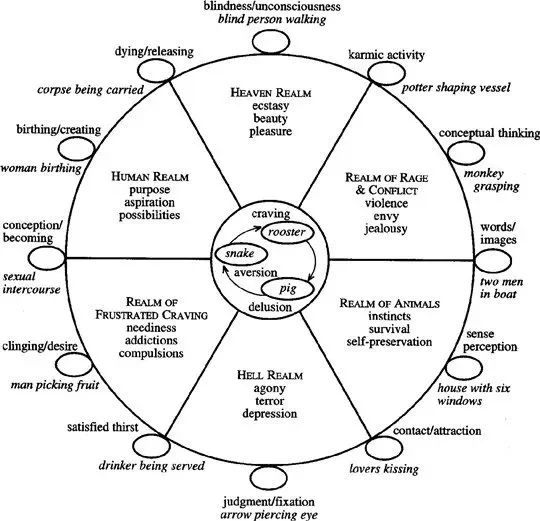Samskaras, Vasanas and Groundhog Day
Groundhog Day
Groundhog Day is one of my favorite movies of all time and I recently had a chance to visit the place that the movie is based on, a quaint little town in the middle of nowhere called Punxsutawney in Pennsylvania. For those who haven’t seen the movie, Groundhog Day tells the story of a cynical television weatherman covering the annual Groundhog Day event in Punxsutawney, Pennsylvania, who becomes trapped in a time loop, forcing him to relive February 2 repeatedly.
I got interested in the movie and its spiritual implications when I was attending a Zen retreat where the visiting teacher, a movie critic, gave a lovely talk on relationship between the movie and spiritual practice.
The Three Layers of Consciousness
To understand samaras and Vasanas, it is good to have a general understanding of how consciousness is described in eastern traditions. In Eastern traditions, our everyday waking consciousness is just one aspect of our entire experience of the world. Typically consciousness in these traditions is divided in three layers, the gross layer, the subtle layer and the deepest layer, called causal layer or alaya consciousness. The karmic imprints for our actions reside in the deepest layer of our consciousness.
In these traditions, most of our everyday actions are determined by these karmic imprints. If you have ever wondered why you end up with the same circumstances in your life despite your conscious effort to change, it is because of our samskaras. Our conscious actions are determined by conditions that reside in our deeper layers of consciousness and are not accessible to our waking consciousness except in deep meditation.
What are Samskaras and Vasanas?
Samskara in these traditions refers to psychological imprints left in the subconscious by our daily experiences—whether conscious or unconscious, internal or external, desirable or undesirable. These imprints are not merely passive vestiges of our actions and intentions, but dynamic forces in our psyche. They constantly push the person into action. These impressions wait to return to the conscious level of the mind, influencing our future in the form of expectations, sense of self-worth, habits, innate dispositions, and emotions—propelling our lives and generating future karma.
Vasana means “to remain,” “to dwell,” “to persist (in memory). Think of Vasanas as “Chains of Samskaras”. In the Yoga Sutras, Patanjali defines vasana as a dynamic chain or concatenation of samskaras. The term vasana is associated with the notion of subtle desire. Because of all the desires we have in daily life, subliminal traces or subtle fingerprints remain in our minds. Within the Causal Layer, the vasanas lie dormant until their “input” is required by the intellect in order to make a decision about how to interpret and respond to a given stimulus. So, for instance, the next time an opportunity for one to share intimacy arises, the vasana formed by our previous pleasurable experience will “tell” your mind that intimacy is enjoyable and you should go ahead and engage in the activity.
Each time we engage in a particular activity or indulge a given vasana, we strengthen it. In this way, over time vasanas gain a sort of life of their own. That is, rather than simply waiting around to be consulted by the intellect when it has to make a decision related to an object with which the vasana is associated, the vasana begins to demand satisfaction, as it were. This is the cause of our desires, attachments, habits, and, in extreme cases, addictions. When they are indulged regularly, vasana can grow strong enough to assume control of our mind.
Vasanas are what make us live in a state of constant agitation—always planning the future and thinking about the past. This prevents us from living in the state of clarity that arises in the awareness of the eternal present moment. In many Eastern traditions this is depicted by a wheel, the constant desire to seek satisfaction from the world around us. Each step feeds on itself and we are constantly cycling between these mental states.
The Six Realms and Flow of Consciousness
Spiritual Practice and the movie Groundhog Day
Below is the talk, and the review of the movie given by Dairyu Michael Wenger, Roshi. It is a beautiful talk that highlights the relationship between spiritual practice and overcoming our Vasanas.
The film Groundhog Day demonstrates the wonder of living each moment as a totally new event. It follows a day in the life of weatherman Phil Connors, a sarcastic curmudgeon. He wakes upon the same day, Groundhog Day, again, and again, and again. His namesake, Phil the groundhog (himself a weatherman), sees his shadow, is frightened and goes back into his burrow, thus predicating six more weeks of Winter. Phil Connors is frustrated by living the same day over and over again. He wants to get somewhere else, find new circumstances, he tries to escape each day with the scenarios of his life. He pursues sex, but after a while it is a dead end. Crime is exciting but becomes tiresome. Drinking, therapy, suicide, finding a love relationship, all are explored. The habits and shadows of his life are found wanting.
Each action has consequences. This is the law of karma: he has a choice, but each choice leads to a new reality. Perhaps the turning point of the movie is when he tries to save a homeless man day after day after day, and, no matter what he does, the man dies. He really wants something and is powerless to insure its happening. We have freedom, but within limits. This is “samsara” in Buddhism, the cycle of becoming driven by our karmic intentional activity. We have desires and wants but we may never reach them. Eventually, through many days [lifetimes] he chooses a life of service, works through his demons, and breaks the cycle of Groundhog Day.
Each moment becomes a new opportunity, so the same situation is brand new and his unique response leads to a unique result.
If we recognize what is driving us, and clarify our true intention, the unexamined shadows are no longer about some solely external reality or objective weather, but about us. Each moment is a new beginning. Our projections and stance in the world can cast a long shadow on our lives, and the Spring of each moment is postponed for a long Winter. If you examine and test your perceptions, each moment brings forth a new world. If we lead an unexamined life, we feel each day is different, but it is really a rerun of our habits. If we examine a disciplined life closely, each instant can blossom into a unique flower.
This film parallels Buddhist practice. In a training temple, the wake-up bell rings the same time every day. You go to the same place, wear the same clothes, and follow the same routine, and yet each moment is unique. Not distracted by your desire for changed conditions, you can live each moment not knowing what it will bring, seeing the familiar landscape with new eyes.
Phil Connors in the end “wins the girl.” He gives up trying to possess her, so that true intimacy, true participation, can occur. Affecting and being affected by each other and each thing is the true interpenetration of self and other.
The cycle of samara is broken, his shadows are seen through, and each moment blossoms. Phil Connors comes out of his burrow to the market place with gift bestowing hands. He sees the shadow of his reflections and bows to it, as it must to him




